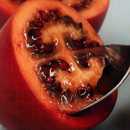Youngberry |
Rubus ursinus CV Young |
| |
||
 |
||
 |
||
 |
||
Youngberry was developed by B.M. Young 1905 Morgan City Louisiana. It is a hybrid between Blackberry 'Phenomenal' and Mayes Dewberry. Was introduced commercially 1926 and became a rival to Loganberry in popularity.
Landscape Value
A very tasty screening plant, on the side of a deck or a fence Try it in a pillar-rose frame as a focal point in the garden or container. Wherever you plant it make sure the fruit can be picked and eaten fresh by you.
Nutritional Value
Youngberries are rich in vitamin C, A, E and dietary fibre. They also contain calcium, phosphorus and potassium.
How to Eat
Straight from the plant, chill for later use in desserts. Berries are idea for jams and jellies, juice or wine. There should be no wastage.
Expected Yield
6 plants will provide ample fruit for a family of four/five.
Generic Fruiting Time
| J | F | M | A | M | J | J | A | S | O | N | D |
Growing
Sun
Plant in full sun or part shade.
Wind
Protect from hot winds
Climate
Prefers mild climates with mild winters.
Soil
Fertile well drained soil, acid to slightly acid. Include generous amounts of organic matter.
Fertiliser
Youngberries are gross feeders so supply regular applications of liquid fertiliser through the growing season.
Pruning
In winter when the plant is dormant gather up the canes and train along the trellis. Cut out the weak, fruited and old canes. Youngberries have a sprawling habit so keep canes off the ground as they will root themselves at a node.
Pests
Apply several copper sprays in winter for fungal disease control. Planted in an open space with free air flow will help keep diseases at bay. DO NOT spray within seven days of harvest. Protect from birds with bird netting.
Special Conditions


